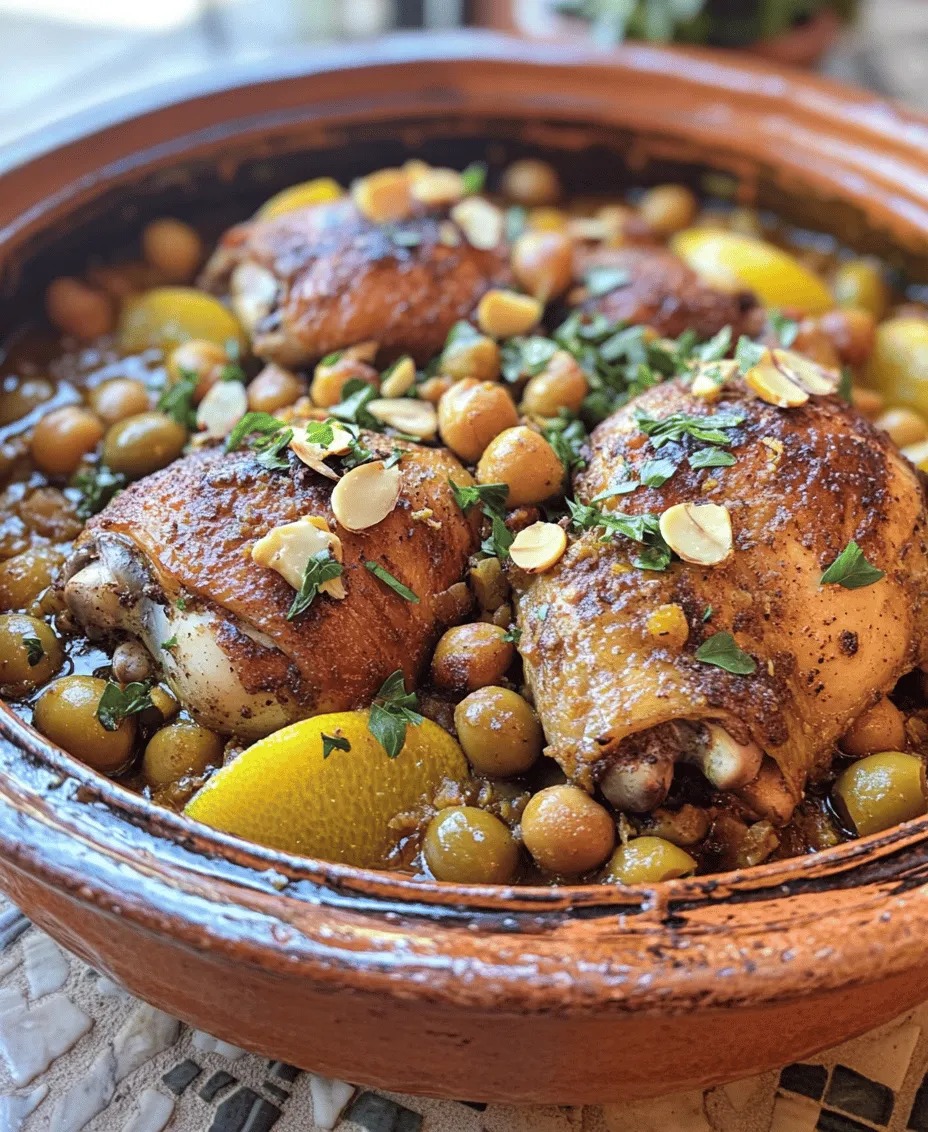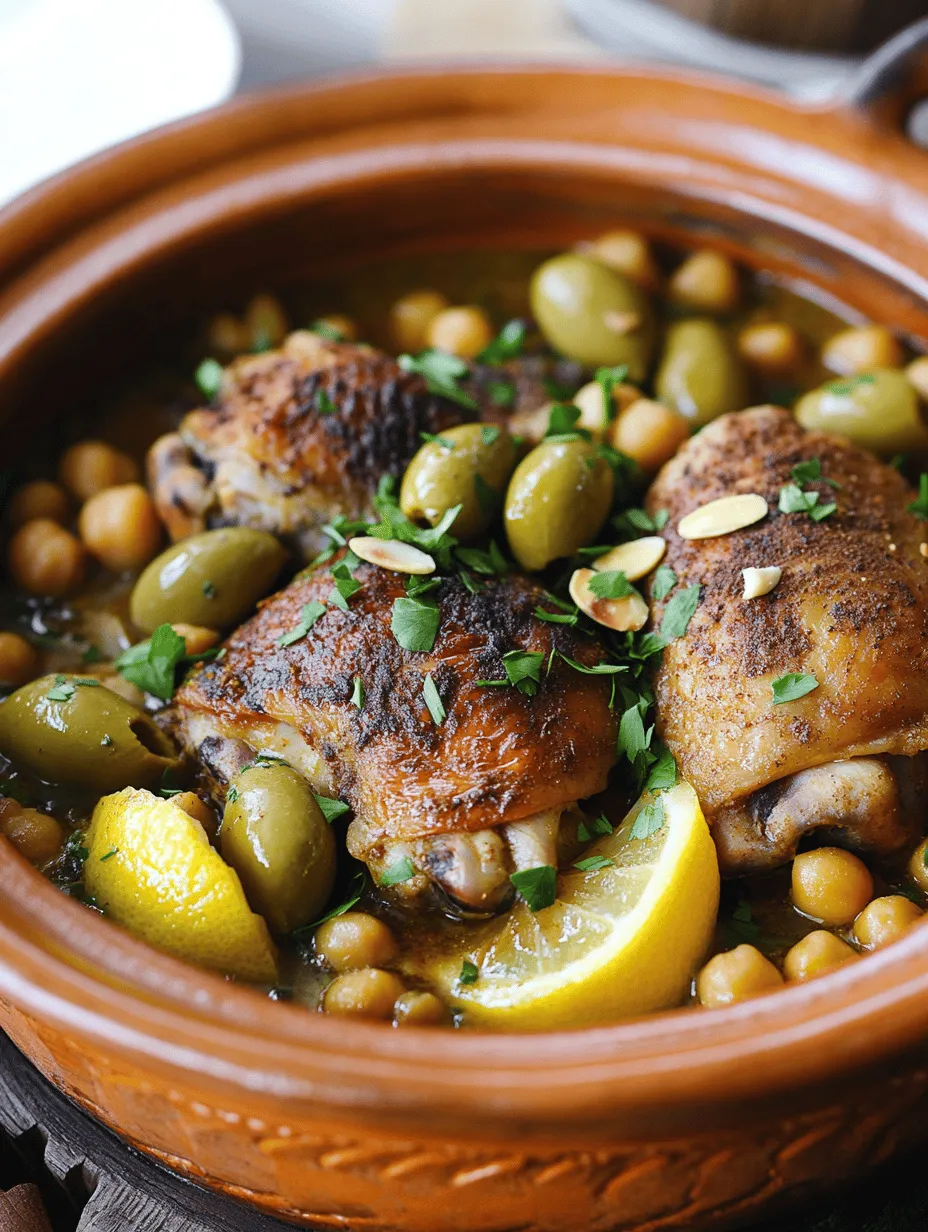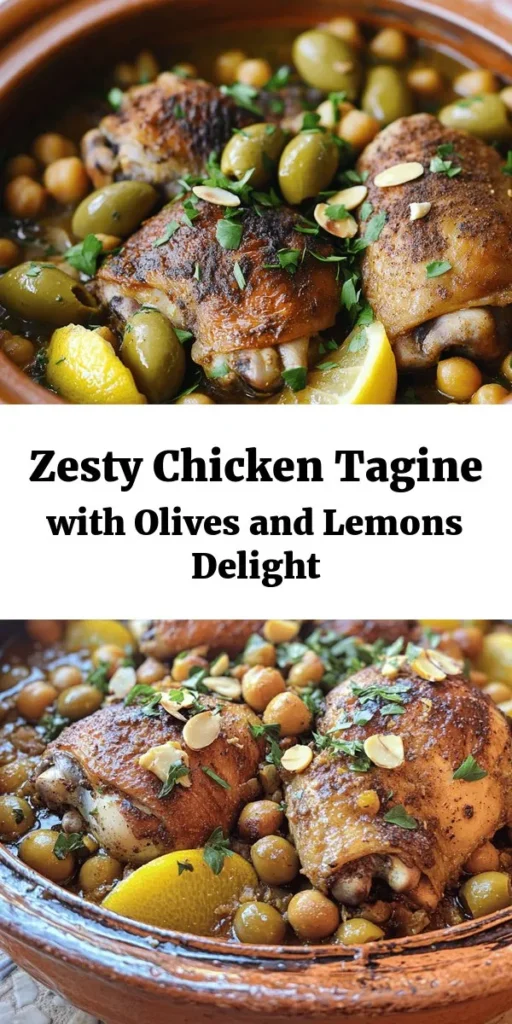Introduction
Moroccan cuisine is a vibrant tapestry of flavors, colors, and aromas that reflects the country’s rich history and cultural diversity. From the bustling souks of Marrakech to the tranquil landscapes of the Atlas Mountains, Moroccan food is a delightful blend of Berber, Arab, and Mediterranean influences. At the heart of this culinary heritage lies the tagine, a traditional North African dish named after the earthenware pot in which it is cooked. Tagines are renowned for their ability to create deeply flavored, slow-cooked meals that are often laden with spices and fresh ingredients.
Among the myriad of tagine recipes, Chicken Tagine with Olives and Lemons stands out as a quintessential Moroccan dish. This recipe showcases the perfect balance of savory and tangy flavors, making it a favorite among both locals and food enthusiasts around the world. The combination of tender chicken, briny olives, and the unmistakable zing of preserved lemons creates a symphony of taste that is both exotic and comforting. What makes this dish particularly appealing to home cooks is its ability to transport one to the streets of Morocco without requiring a culinary degree or exotic cooking skills.
In this article, we will delve into the unique ingredients that make Chicken Tagine with Olives and Lemons a standout dish, and explore the preparation steps that will guide you through the process of creating this flavorful masterpiece in your own kitchen.
Understanding the Ingredients
To fully appreciate the depth of flavor in Chicken Tagine with Olives and Lemons, it is essential to understand the key ingredients that contribute to its distinct profile. Each component plays a crucial role in the dish, ensuring a balance of taste that is characteristic of Moroccan cuisine.
Chicken Thighs: The Foundation of Flavor
While you can use chicken breast for this recipe, bone-in and skin-on chicken thighs are preferred for their rich flavor and juiciness. The bones add depth to the overall taste, while the skin helps to keep the meat moist during cooking. When braised in the aromatic tagine sauce, the thighs become incredibly tender, soaking up all the spices and flavors.
Quality Olive Oil: The Essence of Moroccan Cooking
Olive oil is a staple in Moroccan kitchens, and using a high-quality extra virgin olive oil is essential for this recipe. It not only enhances the flavors of the dish but also adds a smooth richness that complements the spices. Look for a fruity and robust olive oil to elevate your tagine experience.
Spices: The Heart of the Flavor Profile
Moroccan cuisine is known for its intricate use of spices, and Chicken Tagine with Olives and Lemons is no exception. The following spices are vital for infusing the dish with warmth and complexity:
– Ginger: Adds a subtle heat and earthiness.
– Cumin: Provides a nutty and aromatic flavor.
– Cinnamon: Offers a hint of sweetness and warmth.
– Turmeric: Contributes vibrant color and a mild, peppery taste.
– Paprika: Imparts a smoky richness and beautiful color.
Blooming these spices in olive oil before adding the other ingredients helps to release their essential oils, intensifying their flavors and ensuring that every bite is packed with taste.
Olives: A Salty, Briny Kick
Olives are not just a garnish in this dish; they are a key ingredient that brings a salty, briny essence to the tagine. Kalamata olives or green Moroccan olives are both excellent choices, adding depth and a contrasting texture. Their savory flavor pairs beautifully with the sweetness of the chicken and the tanginess of the preserved lemons.
Preserved Lemons: A Tangy Delight
One of the standout elements of Chicken Tagine with Olives and Lemons is the addition of preserved lemons. These lemons are not your ordinary citrus; they are fermented in salt, which transforms their flavor into something uniquely tangy and aromatic. The preserved lemons add a bright note that cuts through the richness of the dish, making each bite refreshing and balanced. If you cannot find preserved lemons at your local store, consider making your own at home or look for them in specialty food shops.
Chickpeas: Texture and Protein
Adding chickpeas to the tagine introduces an additional layer of texture and nutrition. They provide a hearty bite and enhance the dish’s protein content, making it more filling and satisfying. Chickpeas also absorb the flavors from the tagine, contributing to the overall harmony of the meal.
Sourcing Ingredients for Authenticity
To achieve the most authentic flavors in your Chicken Tagine with Olives and Lemons, sourcing quality ingredients is crucial. Here are some tips:
– Preserved Lemons: Look for them in Middle Eastern or Mediterranean grocery stores. You can also find them online or make your own by packing fresh lemons with sea salt and letting them ferment for several weeks.
– Quality Olives: Seek out local specialty shops or farmers’ markets that sell Mediterranean products. Opt for olives that are packed in brine rather than oil for the best flavor.
– Spices: Try to buy whole spices and grind them fresh for the most intense flavor. Look for spices from reputable sources to ensure quality and freshness.
If you cannot find preserved lemons or quality olives, fresh lemon zest and juice can be used as an alternative, but the flavor will not be as complex.
Preparation Steps Explained
Now that we have covered the essential ingredients, let’s dive into the preparation steps involved in making Zesty Chicken Tagine with Olives and Lemons. Each step is designed to build layers of flavor, ensuring that your dish is as delicious as it is aromatic.
Browning the Chicken
The first step in preparing your tagine is to brown the chicken thighs in a hot skillet. This step is essential for developing flavor and creating a beautiful crust on the chicken. Heat a generous amount of olive oil in your tagine or a heavy-bottomed pot, and carefully place the chicken thighs skin-side down. Allow them to cook undisturbed for several minutes until golden brown. This process not only adds depth to the flavor but also keeps the chicken moist during the braising process.
Cooking the Onions and Garlic
Once the chicken is browned, remove it from the pot and set it aside. In the same pot, add finely chopped onions and garlic. These aromatics serve as the foundation for the dish, creating a fragrant base. Sauté the onions until they become translucent and soft, releasing their natural sweetness. Then, add minced garlic and cook for an additional minute, being careful not to let it burn, as this can impart a bitter taste.
Blooming the Spices
With the onions and garlic softened, it’s time to add the spices. This is where the magic happens! Sprinkle the ginger, cumin, cinnamon, turmeric, and paprika over the onion mixture. Stir them in and allow the spices to bloom in the hot oil for about 30 seconds. This technique releases their essential oils, intensifying the flavors that will permeate the entire dish.
Simmering the Dish
After blooming the spices, return the browned chicken to the pot, along with any accumulated juices. Add chopped preserved lemons, olives, chickpeas, and enough chicken broth to cover the chicken. Bring the mixture to a gentle simmer, reduce the heat to low, and cover the pot. This slow cooking process allows the chicken to become tender and soak up all the delicious flavors from the spices, lemons, and olives.
Adjusting Seasonings
As the tagine simmers, it’s important to taste and adjust the seasonings as needed. The balance of flavors is vital in Moroccan cuisine, so feel free to add more salt, pepper, or a touch of honey if you prefer a sweeter profile.
With these initial steps, you are well on your way to creating a beautifully aromatic and flavorful Zesty Chicken Tagine with Olives and Lemons. The combination of tender chicken, zesty lemons, and briny olives will transport you to the heart of Morocco, making this dish a perfect addition to your culinary repertoire. Stay tuned for the next part, where we will cover the final touches and presentation of this delightful dish!

Cooking Equipment and Tools
To make the perfect Zesty Chicken Tagine with Olives and Lemons, having the right cooking equipment is essential. While you can prepare this dish in various types of cookware, utilizing a traditional tagine provides unique benefits that elevate the final outcome.
Essential Cookware for Preparing Chicken Tagine
A tagine is a traditional Moroccan cooking vessel that consists of two parts: a flat, circular base and a conical lid. This design allows for even heat distribution and excellent moisture retention, which is crucial for braising the chicken and infusing it with the rich flavors of spices and aromatics. If you have a tagine, it is undoubtedly the best option for this recipe.
Benefits of Using a Tagine vs. a Heavy-Bottomed Pot
Using a tagine not only enhances the cooking process but also adds a layer of authenticity to your dish. The conical lid helps to trap steam, allowing the chicken to cook gently while keeping it tender and juicy. The tagine’s design also encourages the melding of flavors, so each bite is bursting with the essence of spices like cumin, coriander, and saffron. In contrast, while a heavy-bottomed pot will work, it may not provide the same depth of flavor or moisture retention, which could result in a drier dish.
Suggested Alternatives for Home Cooks Without Specialized Equipment
If you don’t have a tagine, fear not! A Dutch oven or any heavy-bottomed pot with a tight-fitting lid will suffice. These options can provide similar cooking results, ensuring your chicken tagine is flavorful and moist. Just ensure that you monitor the heat carefully to prevent the dish from drying out during the cooking process.
Importance of a Lid in Retaining Moisture and Flavor During Cooking
Regardless of the cookware you choose, using a lid is crucial. It helps to trap steam and heat, allowing the ingredients to cook evenly while preserving their flavors and moisture. This is especially important for a dish like chicken tagine, where the goal is to achieve tender chicken that falls off the bone and a sauce that’s rich and deeply flavored.
Serving Suggestions
Once your Zesty Chicken Tagine is ready, serving it correctly can enhance the overall dining experience.
Traditional Accompaniments for Chicken Tagine
Traditionally, chicken tagine is served with couscous, a staple in Moroccan cuisine. The light, fluffy grains soak up the flavorful sauce from the tagine, creating a perfect balance.
Couscous: How to Prepare It Perfectly for Serving
To prepare couscous, measure out 1 cup of couscous and place it in a bowl. Boil 1.5 cups of water or chicken broth and pour it over the couscous. Cover the bowl with a lid or plastic wrap and let it sit for about 5-10 minutes. After the couscous has absorbed the liquid, fluff it with a fork and stir in a tablespoon of olive oil and a pinch of salt to enhance its flavor.
Alternative Sides: Crusty Bread and Salads
For a variation, consider serving the tagine with crusty bread, which is perfect for scooping up the succulent chicken and sauce. A fresh salad made with cucumbers, tomatoes, and a lemon-olive oil dressing can also complement the dish beautifully, providing a refreshing contrast to the rich flavors of the tagine.
Presentation Tips for an Appealing Serving Style
When serving your chicken tagine, consider using the tagine itself as a centerpiece for a beautiful presentation. Serve it directly from the tagine onto plates, or if you’re using a pot, transfer the dish to a large serving platter. Arrange the chicken pieces artistically, pouring some sauce over the top to create an inviting look.
Garnishing with Parsley and Almonds for Texture and Visual Appeal
To add a finishing touch, garnish the dish with freshly chopped parsley and a sprinkle of slivered almonds. This not only adds a pop of color but also introduces a delightful crunch that contrasts with the tender chicken and soft couscous or bread.
Health Benefits of the Ingredients
Understanding the health benefits of the ingredients in your Zesty Chicken Tagine can make your meal even more satisfying and nutritious.
Nutritional Profile of Chicken Thighs and Their Role in a Balanced Diet
Chicken thighs are known for their rich flavor and juicy texture. They are an excellent source of protein, which is essential for muscle growth and repair. Unlike chicken breasts, thighs offer a higher fat content, providing a source of energy and helping to keep you satiated longer. They also contain important vitamins and minerals, including B vitamins that support metabolism and immune function.
Benefits of Olives and Chickpeas: Healthy Fats and Plant-Based Protein
Olives are a key ingredient in this recipe, adding briny flavor and healthy monounsaturated fats, which can help reduce bad cholesterol levels and lower the risk of heart disease. Chickpeas, often included in Moroccan tagines, provide plant-based protein and fiber, promoting digestive health and keeping you full. Together, these ingredients create a balanced dish that supports overall health.
The Significance of Spices: Health Benefits Associated with Each Spice Used in the Recipe
The spices used in this tagine—such as cumin, coriander, cinnamon, and saffron—not only enhance flavor but also offer various health benefits. Cumin aids digestion, while coriander has antibacterial properties. Cinnamon is known for its anti-inflammatory effects and may help regulate blood sugar levels. Saffron, often considered a luxury spice, is rich in antioxidants and may improve mood.
Preserved Lemons: Their Unique Contribution to Flavor and Potential Health Benefits
Preserved lemons are a hallmark of Moroccan cuisine, adding a unique tartness that elevates the dish. They are rich in vitamin C, which supports the immune system, and their fermentation process may aid digestion. The zest and pulp are often used, providing a depth of flavor that fresh lemons cannot replicate.
Cultural Significance of Tagine
Exploring the cultural significance of tagine cooking can deepen your appreciation for this dish.
Historical Background of Tagine Cooking in Moroccan Culture
Tagine cooking has roots that trace back centuries in Moroccan culture. The vessel itself has been used for generations to create meals that are not only flavorful but also celebratory. The slow-cooking method allows for the melding of spices and ingredients, making it a communal dish often shared among family and friends.
The Communal Aspect of Sharing a Tagine Meal
In Moroccan culture, food is often shared, and meals are a time for gathering. A tagine is typically placed at the center of the table, with diners serving themselves directly from the pot. This communal approach fosters a sense of togetherness and hospitality, reflecting the values of generosity and warmth that are central to Moroccan life.
How This Dish Reflects Moroccan Hospitality and Tradition
A well-prepared tagine is a symbol of Moroccan hospitality. It’s common for hosts to go above and beyond to prepare a delicious meal for guests, and presenting a tagine showcases their culinary skills and willingness to share their culture. Sharing a meal in this way encourages conversation and connection, making it a cherished tradition.
Conclusion
The Zesty Chicken Tagine with Olives and Lemons is more than just a meal; it’s an experience that brings together rich flavors, cultural significance, and communal joy. Whether you’re preparing it for a special occasion or a cozy family dinner, this dish promises to impress.
As you explore Moroccan cuisine through this recipe, you’ll discover the joy of cooking and the pleasure of sharing meals with loved ones. Don’t hesitate to experiment with the ingredients or presentation, allowing your creativity to shine. Each time you make this dish, you’ll not only enjoy its deliciousness but also embrace the warmth of Moroccan hospitality.
So, gather your ingredients, choose your cookware, and embark on a culinary journey that will transport you to the heart of Morocco. Enjoy the process, savor the flavors, and relish the moments spent with those who gather around your table.



